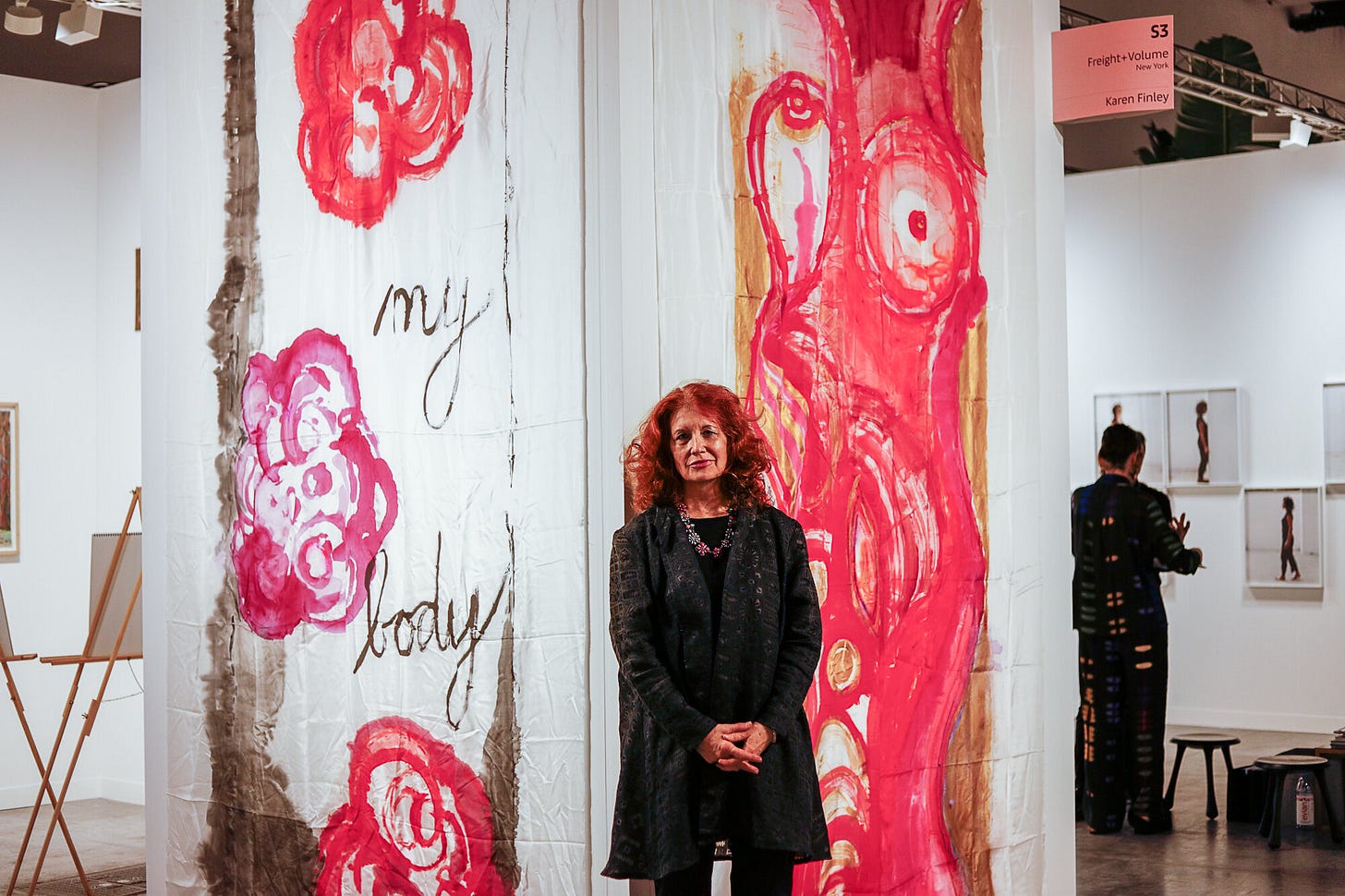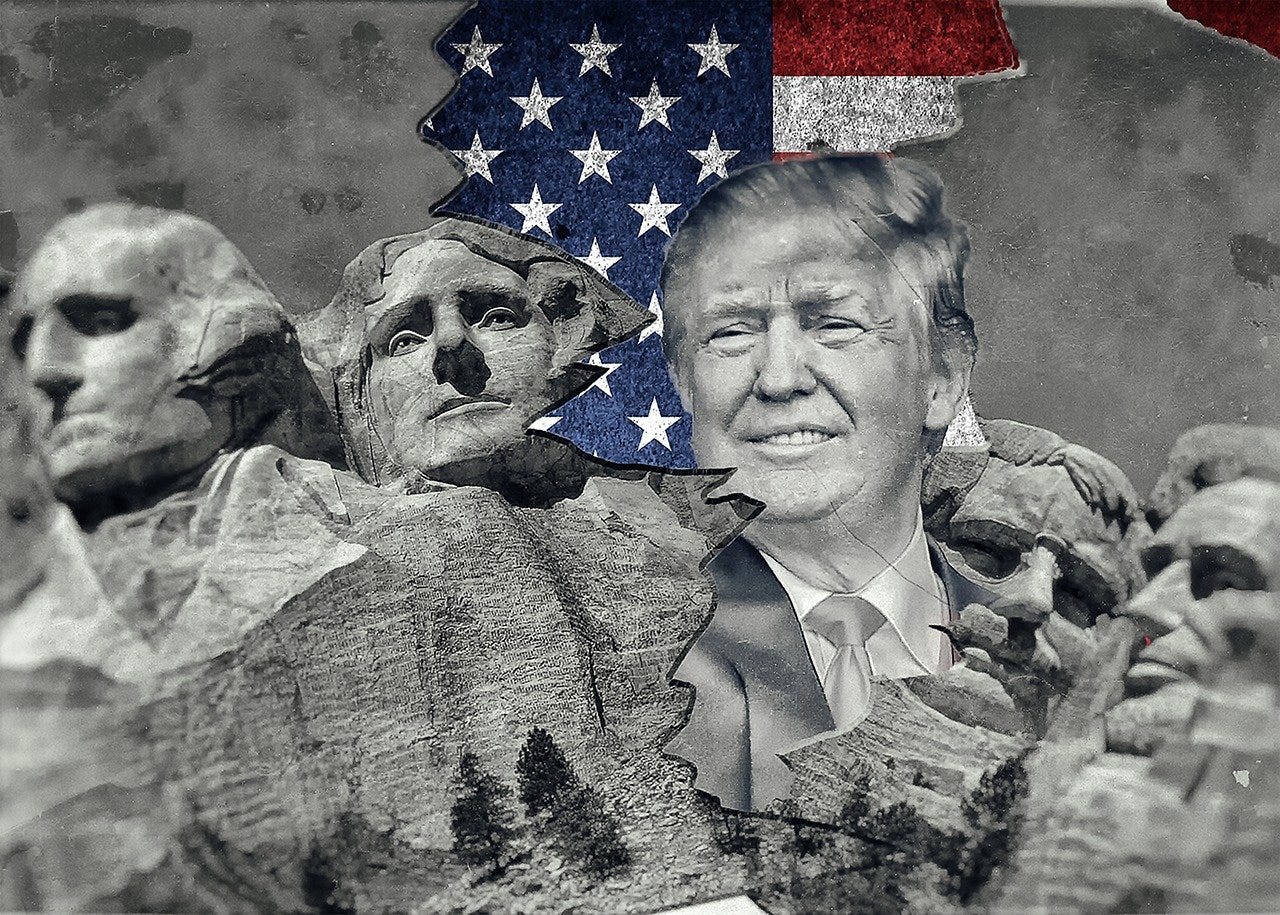Trump and Artists
Will his maneuvers rock your world? Or simply make you nauseated and angry?
A few of my friends have been able to turn off the news feeds emanating from the alarming Musk-Trump takeover of the government, but I’m afraid I’m obsessed. I regularly wake up around 2 or 3 a.m. and tune into reports from the front. Yes, it’s enough to curl your toes and ruin your sleep for the rest of the night, but I’m hooked—until I make a more concerted effort to just say no. Like any addict.
In only the past few days, Trump purged the country’s military leadership, further consolidating an authoritarian regime; threatened to withdraw from the NATO alliance, which has kept the world safe for 80 years from another global war; accused Ukraine of starting the war with Russia and called President Zelensky a dictator; cozied up to Putin in a one-and-a-half-hour phone call; and all but declared himself king by posting a computer-generated image of himself grinning on a fake Time magazine cover while donning a golden crown.
And of course there’s been lots more going on. Tens of thousands of federal workers have been laid off, including Forest Service personnel who warn of an increase in wildfires because of the cuts, “multiple staff” at the nuclear safety commission (who were then “unfired” but couldn’t be reached because the email system went down), and thousands of workers at the IRS (um, sorry, but your refund check might be late this year, or lost in the mail). As of Friday, Trump was also threatening to take over the postal service (do your Christmas shopping early this year).
The list just goes on and on, with some shocking footnotes, like Forbes reporting that Elon Musk received “substantial Federal funds” to help his companies, Tesla and SpaceX, find their footing when they were fledgling, unproven startups over 15 years ago.
But the point of this newsletter is to provide information for an audience of artists, and so let’s go through some of the changes that affect people who care about the visual arts.
Closing Offices of Diversity, Equity, and Inclusion
Both the National Gallery and the Smithsonian Institution, which oversees 21 national museums—like the Hirshhorn, the National Portrait Gallery, and the National Air and Space Museum—have been forced to shutter DEI programs, which were established under President Biden to advance “equity for all, including people of color and others who have been historically underserved, marginalized, and adversely affected by persistent poverty and inequality.” The Trump reversal of DEI offices means, effectively, that people of color or of a different sexual orientation need not apply for any of the 40 job openings at Smithsonian institutions.
How this will affect future programs and shows at the various museums remains to be seen, but in the world of commerce, many companies have been reducing or eliminating DEI programs, including Amazon, Google, Ford, Harley-Davidson, John Deere, Lowe's, McDonald's, and Walmart. Does that mean only white people can find jobs at these companies? We don’t know yet, but it’s a very bad look, as they say.
The National Endowment for the Arts
Restrictions to the NEA could hurt any number of individual artists and arts organizations. New requirements for grant applicants were put in place this month to comply with executive orders signed by Trump. One states that applicants “not operate any programs promoting ‘diversity, equity, and inclusion’ that violate any applicable federal anti-discrimination laws”; the other is that federal funds not be used “to promote gender ideology,” referring to an executive order, prompted by Mr. Trump’s concern about public policy toward transgender people, that declares that American policy is “to recognize two sexes, male and female.”
In response, nearly 500 artists sent a protest last week to the NEA. “We oppose this betrayal of the Endowment’s mission to ‘foster and sustain an environment in which the arts benefit everyone in the United States,'” reads the letter spearheaded by New York-based writer and theater director Annie Dorsen. Holly Hughes, one of four performance artists denied NEA funding in 1990 after conservatives protested, observed that "these funding restrictions are a good barometer for who is the easy punching bag in American culture at the moment."
The NEA Four, as the artists were called 35 years ago, won their case in court in 1993 and were awarded amounts equal to the grant money in question. When the case made its way to the Supreme Court, however, the justices ruled in favor of the NEA's decision-making process. In response, the NEA, under pressure from Congress, stopped funding individual artists.
But the grants also fund any number of endeavors across the U.S., especially in what is called “underserved communities,” and those may be in danger of losing any financial support. In my home state of New Mexico, NEA grants totaling nearly $500,000 have gone toward the support of the Santa Fe Opera, the Georgia O’Keeffe Museum, the Santa Fe Film Institute, and others.
Earlier this month, the NEA announced the indefinite removal of the “Challenge America” grant nationwide for the fiscal year of 2026, according to the organization’s website. “Challenge America” is a diversity, equity and inclusion grant for disadvantaged communities and small programs. In my immediate area this includes Ballet Taos, the Millicent Rogers Museum, and SciArt Santa Fe.
New guidelines from the NEA encourage projects that celebrate the 250th anniversary of the signing of the Declaration of Independence by the Founding Fathers. So, if you are an arts organization applying for funds, try to work an old white guy in a wig into your proposal.
Tariffs, Art Supplies, and More Zombie Formalism
Tariffs are a source of confusion for many in the art world, as Trump threatens these, primarily on Mexico and Canada, and then presses the pause button. There’s already a 7.5 percent tariff on art from China, and the administration imposed an additional 10 percent on goods like antiques and “information materials,” but art is excluded. “Many Western artists produce large-scale sculptures at foundries in China,” Jared Muscato, an art logistics specialist told ARTnews. “The 7.5 percent duty applies to those works, even as creations of European and/or U.S. based artists.”
Even with the tariff exemption for artworks, many art supplies, business supplies, electronics, lumber (art crates and stretcher bars), event supplies, and inexpensive art-related merchandise (tote bags, sweatshirts, T-shirts, socks, umbrellas, and toys) manufactured in China will now be subject to a whopping 17.5 percent tariff if they are imported to the US, reports ARTnews.
After the pause on Canada and Mexico ends next month, retaliatory tariffs from Canada in particular may mean that artists will be paying higher prices for paper used by printmakers, photographers, and book publishers.
As for art collecting, “the return of Donald Trump will bring tax reforms that favor high-net-worth individuals, which boosts high-end art purchases,” Magnus Resch, the New York-based author of the 2024 book, How to Collect Art, told the Art Newspaper. “A more crypto-friendly administration may also reignite interest in NFTs and blockchain-based art transactions.”
“Can dealers afford to represent artists whose works are left-leaning and politically hard-edged when so many of those with the money to buy serious contemporary works are leaning to the right?” the same article asked. “The market’s solution—clearly visible in galleries, fairs and auctions of resold works by contemporary artists—is painting that seems politically neutral and in some way calmingly decorative.” Like the kind of Zombie formalism identified by the late artist and critic Walter Robinson.
Trump’s Aesthetics
To speak of taste and Trump in the same sentence borders on breathtakingly oxymoronic, but the man does have his preferences in music, interior decoration, and the visual arts. We know that he likes gold and glitz, lots and lots of it, at his homes in Mar-a-Lago and the Trump Tower in Manhattan. During his first term as president, he asked to borrow a van Gogh from the Guggenheim’s collection. The museum said no but did offer Maurizio Cattelan’s 18-karat gold toilet, called America, in its stead (the fully functioning loo, used by an estimated 100,000, was a not-so-subtle jab at the insanity of the art market).
Trump has already injected beaucoup d’or, as in Louis XIV’s heyday, into the official precincts of the White House. According to the Times, he’s introduced “gold vases and statuettes and at least one gold figurine embedded in an elevated wall molding.” And he wants to install a grand chandelier in the oval Office and uproot the grass in the Rose Garden, possibly replacing it with a hard surface like the one he has for his dance floor at Mar-a-Lago.
For the 250th anniversary of the signing of the Declaration of Independence, he is reviving an idea floated during his first term for a “National Garden of American Heroes,” and to his credit he has mentioned including Black American icons like Harriet Tubman, Frederick Douglass, Aretha Franklin, and Muhammed Ali. He claims to be picking final sites now, acknowledging this probably won’t get done by July. Nothing has been said about the sculptures or the materials, but in an earlier directive, he said that the statues must be “lifelike or realistic,” not “abstract or modernist.”
In the realm of the monumental, he has also proposed that his face be added to Mr. Rushmore. Vive le roi!
What You Can Do
I realize this is a long post, but as I did all this research, I came to see grounds for optimism. It’s doubtful Trump will ever resort to the kind of tactics Hitler employed, when he supported only shows of Nazi-sanctioned art and launched a thorough head-hunting of artists, dealers, and museum directors who did not comply with his aesthetics. But your local arts centers may be endangered, and tariffs will hurt everyone. And the hundreds of thousands of people out of work will have a ripple effect on the economy and national morale. (I’ve been wondering: Will they get unemployment checks?)
If you’re moved to take part in protests, there is a “no buy” strike scheduled for Friday February 28, and calling your local representatives is still a good way to exert pressure (reports claim the phone lines have been flooded, as much as 4000 percent over the normal volume). The Substack newsletter Chop Water/Carry Wood has daily updates on ways to take action, complete with scripts to follow when writing or making phone calls.
God bless America….and save her too.
I would love to hear if you feel your work and life have been impacted by this administration in any way.









To continue to make work - that is paramount - that is my job - material culture. Ride the wave. I have yet to be surprised. I believe in keeping friends close and "enemies" closer. Not watching the news is not a good thing. Watching too much news, the same. This is a marathon - how do I "train"? To live through this time - to tell about it after. Finally, I have family who have worked for USAID for many years. Africa, Ukraine, Jordan - their lives are now turned upside down and I would offer, those they have served for so many years are now in the most severe of circumstances - their lives are at stake.
Thanks Ann, this post supporting art and artists is great. I'm all in, writing postcards for Wisconsin election, protesting at Boston Common while trying to keep my sanity. Feb 28 is a great idea and my hope is that it will be repeated often. I read news and stay informed so I can react and resist as I can. I hope others will too, please don't drop out, be strong and act.